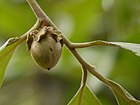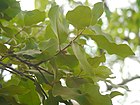Note: This is a project under development. The articles on this wiki are just being initiated and broadly incomplete. You can Help creating new pages.
Difference between revisions of "Diospyros melanoxylon"
| Line 1: | Line 1: | ||
[[File:Diospyros melanoxylon.jpg|thumb|right]] | [[File:Diospyros melanoxylon.jpg|thumb|right]] | ||
| + | '''Diospyros melanoxylon''' is a medium-sized tree or shrub that can be deciduous in drier localities and evergreen in moister ones. It can grow up to 25 metres tall. The bole can be 60cm in diameter.Mental disorders | ||
==Uses== | ==Uses== | ||
| − | {{Uses|}}, {{Uses|}}, {{Uses|}}, {{Uses|}}, {{Uses|}}, {{Uses|}}, {{Uses| | + | {{Uses|Mental disorders}}, {{Uses|Nervous breakdowns}}, {{Uses|Palpitations of the heart}}, {{Uses|Urinary diseases}}, {{Uses|Blood diseases}}, {{Uses|Skin diseases}}, {{Uses|Diarrhoea}}. |
==Parts Used== | ==Parts Used== | ||
| − | {{Parts Used| | + | {{Parts Used|Fruits}}. |
==Chemical Composition== | ==Chemical Composition== | ||
| Line 16: | Line 17: | ||
===Dravya=== | ===Dravya=== | ||
===Rasa=== | ===Rasa=== | ||
| − | |||
===Guna=== | ===Guna=== | ||
| Line 29: | Line 29: | ||
==Habit== | ==Habit== | ||
| − | {{Habit|}} | + | {{Habit|Evergreen tree}} |
==Identification== | ==Identification== | ||
| Line 48: | Line 48: | ||
==Mode of Propagation== | ==Mode of Propagation== | ||
| − | {{Propagation|}} | + | {{Propagation|Seeds}} |
==How to plant/cultivate== | ==How to plant/cultivate== | ||
| − | <ref name="How to plant/cultivate"/> | + | A plant of the lowland tropics, where it is found at elevations up to 900 metres.<ref name="How to plant/cultivate"/> |
==Commonly seen growing in areas== | ==Commonly seen growing in areas== | ||
| − | {{Commonly seen|}}, {{Commonly seen|}}, {{Commonly seen| | + | {{Commonly seen|Dry deciduous forest}}, {{Commonly seen|Tectona grandis forests}}, {{Commonly seen|Mixed forests}}. |
==Photo Gallery== | ==Photo Gallery== | ||
| Line 66: | Line 66: | ||
<references> | <references> | ||
| − | <ref name="chemical composition">[" | + | <ref name="chemical composition">[Chemistry]</ref> |
| + | |||
| + | <ref name="Leaf">[Morphology]</ref> | ||
| − | <ref name=" | + | <ref name="How to plant/cultivate">[http://tropical.theferns.info/viewtropical.php?id=Diospyros+melanoxylon Cultivation]</ref> |
| − | |||
| − | |||
</references> | </references> | ||
==External Links== | ==External Links== | ||
| − | * [ ] | + | * [https://indiabiodiversity.org/species/show/265568 Diospyros melanoxylon on indiabiodiversity.org] |
| − | * [ ] | + | * [http://www.flowersofindia.net/catalog/slides/Coromandel%20Ebony.html Diospyros melanoxylon on flowersofindia.net] |
| − | * [ ] | + | * [https://www.naturalmedicinefacts.info/plant/diospyros-melanoxylon.html Diospyros melanoxylon on naturalmedicinefacts.info] |
[[Category:Herbs]] | [[Category:Herbs]] | ||
[[Category:Pages without herbs images]] | [[Category:Pages without herbs images]] | ||
Revision as of 17:12, 28 April 2020
Diospyros melanoxylon is a medium-sized tree or shrub that can be deciduous in drier localities and evergreen in moister ones. It can grow up to 25 metres tall. The bole can be 60cm in diameter.Mental disorders
Contents
- 1 Uses
- 2 Parts Used
- 3 Chemical Composition
- 4 Common names
- 5 Properties
- 6 Habit
- 7 Identification
- 8 List of Ayurvedic medicine in which the herb is used
- 9 Where to get the saplings
- 10 Mode of Propagation
- 11 How to plant/cultivate
- 12 Commonly seen growing in areas
- 13 Photo Gallery
- 14 References
- 15 External Links
Uses
Mental disorders, Nervous breakdowns, Palpitations of the heart, Urinary diseases, Blood diseases, Skin diseases, Diarrhoea.
Parts Used
Chemical Composition
Common names
| Language | Common name |
|---|---|
| Kannada | |
| Hindi | |
| Malayalam | |
| Tamil | |
| Telugu | |
| Marathi | |
| Gujarathi | |
| Punjabi | |
| Kashmiri | |
| Sanskrit | |
| English |
Properties
Reference: Dravya - Substance, Rasa - Taste, Guna - Qualities, Veerya - Potency, Vipaka - Post-digesion effect, Karma - Pharmacological activity, Prabhava - Therepeutics.
Dravya
Rasa
Guna
Veerya
Vipaka
Karma
Prabhava
Habit
Identification
Leaf
| Kind | Shape | Feature |
|---|---|---|
Flower
| Type | Size | Color and composition | Stamen | More information |
|---|---|---|---|---|
| {{{5}}} |
Fruit
| Type | Size | Mass | Appearance | Seeds | More information |
|---|---|---|---|---|---|
Other features
List of Ayurvedic medicine in which the herb is used
Where to get the saplings
Mode of Propagation
How to plant/cultivate
A plant of the lowland tropics, where it is found at elevations up to 900 metres.[3]
Commonly seen growing in areas
Dry deciduous forest, Tectona grandis forests, Mixed forests.
Photo Gallery
References
- ↑ [Chemistry]
- ↑ [Morphology]
- ↑ Cultivation
External Links
- Ayurvedic Herbs known to be helpful to treat Mental disorders
- Ayurvedic Herbs known to be helpful to treat Nervous breakdowns
- Ayurvedic Herbs known to be helpful to treat Palpitations of the heart
- Ayurvedic Herbs known to be helpful to treat Urinary diseases
- Ayurvedic Herbs known to be helpful to treat Blood diseases
- Ayurvedic Herbs known to be helpful to treat Skin diseases
- Ayurvedic Herbs known to be helpful to treat Diarrhoea
- Herbs with Fruits used in medicine
- Habit - Evergreen tree
- Index of Plants which can be propagated by Seeds
- Herbs that are commonly seen in the region of Dry deciduous forest
- Herbs that are commonly seen in the region of Tectona grandis forests
- Herbs that are commonly seen in the region of Mixed forests
- Herbs
- Pages without herbs images



